|
|
| |
ITALY
PALERMO
HISTORY, LANDMARKS, MUSEUMS AND GALLERIES
History
Palermo was founded in the 8th century BC by Phoenician tradesmen around a natural harbour on the north-western coast of Sicily.
In the 9th century, Sicily was divided into two prefectures by the Byzantines. The two prefects went to war with each other, and Euphimius, the winner, dreamt of reuniting the Roman empire. However, he lacked an army, so he asked the Arab Aghlabids rulers of North Africa, at the time the up-and-coming power in the Mediterranean, to lend him theirs. Within a week of the Arabs' arrival in Palermo in 827, Euphimius died mysteriously, and they declined to leave. By 878 all of Sicily, except for a few Byzantine enclaves near Taormina, was controlled by the Saracens (Moors). The Arab rulers moved Sicily's capital to Palermo where it has been ever since.
Under Muslim dominion Palermo became an important commercial and cultural center, a flourishing city broadly known in the whole Arab world - it is said that it had more than 300 mosques.
 Photo PKG
In 1060 the Normans launched a crusade against the Muslim emirate of Sicily, taking Palermo on January 10, 1072 and the whole island by 1091. The resulting blend of Norman and Arab culture fostered a unique hybrid style of architecture as can be seen in the Palatine Chapel, the church San Giovanni degli Eremiti and the Zisa.
Sicily in 1194 fell under the control of the Holy Roman Empire. Palermo was the preferred city of the Emperor Frederick II. After an interval of Angevin rule (1266-1282), Sicily came under the house of Aragon and later, in (1479), the kingdom of Spain.
 Photo PKGSicily's unification (1734) with the Bourbon-ruled kingdom of Naples as the kingdom of the Two Sicilies inflicted a devastating blow on the elite of Palermo, as the city was reduced to just another provincial city, the royal court residing in Naples. Palermo rebelled in 1848 and held out against the Neapolitan crown until May 1849.
The Italian Risorgimento and Sicily's annexation (1860) to the kingdom of Italy gave Palermo a second chance. It was once again the administrative centre of Sicily, and there was a certain economic and industrial development. In the second half of the 19th century Palermo expanded beyond the historical centre, especially towards Via della Libertá. Monumental public buildings were erected and a new thoroughfare was cut into the dense old town, called Via Roma. The city was one of the main centres of Art Nouveau style in Italy.
The importance of Palermo got another boost when Sicily became (1947) an autonomous region with extended self-rule. But any improvement was thwarted by the rising power of the Mafia, which still today is a dramatic feature of the city, as well as the whole Southern Italy.
Palermo is a city of almost three millennia of history, beautiful palaces and churches, colourful markets, marvelous food and a distinctive cultural identity.
Palermo Cathedral
The Cathedral of Palermo is an architectural complex in Palermo. It is characterized by the presence of different styles, due to a long history of additions, alterations and restorations, the last of which occurred in the 18th century.
 Photo PKG
The cathedral is located at Corso Vittorio Emanuele, corner of Via Matteo Bonello, Palermo.
The Teatro Massimo
The Teatro Massimo is the largest theatre in Italy (and the third largest opera house in Europe). Basile was inspired by ancient and classical Sicilian architecture and, thus, the exterior was designed in the high neoclassical style incorporating elements of the Greek temples at Selinunte and Agrigento.
 Photo PKG Realized in the late-Renaissance style, the auditorium was planned for 3,000 people, but, in its current format, it seats 1,350, with 7 tiers of boxes rising up around an inclined stage, and shaped in the typical horseshoe style.
San Giovanni degli Eremiti (St. John of the Hermits)
The church's origin date to the 6th century. Later, after the Islamic conquest of Sicily, it was turned into a mosque. After the establishment of the Norman domination of southern Italy, it was returned to the Christian cult by Roger II of Sicily who, around 1136, entrusted it to the monks of St. William from Vercelli.
 Photo PKG
The church was extensively modified during the following centuries. A restoration held around 1880 attempted to restore its original medieval appearance. The church is notable for its brilliant red domes, which show clearly the persistence of Arab influences in Sicily at the time of its reconstruction in the 12th century
Palermo Botanical Garden
The Orto Botanico di Palermo (Palermo Botanical Garden) is both a botanic garden and a research and educational institution forming part of, and managed by, the Department of Botany of the University of Palermo. The garden lies within the city of Palermo at 10 metres above sea-level. It covers about 30 acres on top of red soil that has evolved on a calcareous tufaceous substratum.
| |
|
Festivals & Events
Vinum Bonum
This is a very special period in Valley Veneggia just south of Bolzano and just north of the upper tip of Lake Garda. For the entire month of August there are musical concerts held in a variety of the 27 wine-gowing 'cantinas' in the valley selected by a governing board for the high quality of the wines they produce. The tastings all begin at 4:30 in the afternoon and conclude at 7:00 PM and are only held on Tuesdays, Thursdays and Fridays.
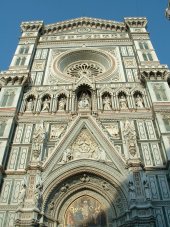 St. Maria del Fiore, Florence
Photo: BPG
International Piano Festival - Amalfi
July and August
The Chiostro del Paradiso is the setting for concerts by Italian and foreign pianists who alternate playing every Friday.
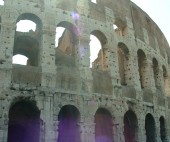 The Colosseum, Rome
Photo: BPG
MUSICAL WEEKS
Siena
August
Accademia Musicale Chigiana
Via di Città 89 - 53100 Siena
Tel. 39 0577 46152
Fax 39 0577 288124
Spoleto
June - July
Associazione Festival dei Due Mondi
Piazza Duomo 8 - 06049 Spoleto
Tel. 39 0743 220320 or 45028 or 40619
Fax 39 0743 220321
e-mail: spoletofestival@krenet.it
Torre del Lago Festival Pucciniano
August
Torre del Lago Puccini
Piazzale Belvedere 4 - 55048 Viareggio (Lucca)
Tel. 39 0584 350562
Fax 39 0584 350277 or 350562
Umbria Umbria Jazz
July
"Associazione Umbria Jazz"
P.O. Box 228 - 06100 Perugia
Tel. 39 075 62432
Fax 39 075 5730053
Viterbo Baroque Music Festival
August
Palazzo Santoro - Piazza Verdi 4/A 01100 Viterbo
Tel.39 0761 326666
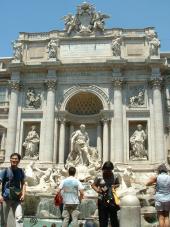 The Trevi Fountain, Rome
Photo: BPG
Ivrea Carnival
Early January
(lasts for 5 days)
In 2001 the carnival celebrated its 194th edition, but the area had started celebrating the events as early as the 1600s. The fight for liberty, when the men of Ivrea "expelled" the Marquis of Monferrato, is recreated with the Battles of the Oranges, which substitute stones. To make it fun there are several orange throwing "teams", all sporting colorful uniforms. The Carnival also has a lot of parties, food events and music.
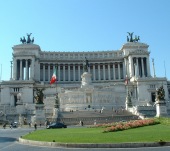 Vittorio Emanuele Monument, Rome
Photo: BPG
San Gennaro - Naples
September
San Gennaro, patron saint and protector of Napoli, stands for many as a symbol of the city itself, and his festival is one of the most passionately celebrated in all of Italy.
The festival ideally culminates in the miracle of the liquefaction of the blood of San Gennaro, which takes place every year more or less on the date of the festival. Many accept the divine nature of the event, and it is incontestable that the blood liquefies, but experts obviously differ on why or how this happens.
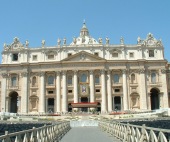 St. Peter's Basilica, Rome
Photo: BPG
Easter Sunday Florence
The annual 'holy fire' during Holy Week, is started with historical shards of the Holy Sepulchre, and is lit in the Church of SS Apostoli and transported to the Duomo, where the archbishop of the city lights the sacred 'Colombina' rocket with it during the Easter Mass. The rocket travels out of the Duomo along a wire, sets fire to the huge array of fireworks attached to the ICARRO and returns back into the church the way it came.
The celebration of the ceremony still bears a strong resemblance to the way in which it has been celebrated for centuries. On the morning of the day the Carro, pulled by two white oxen, leaves from Via del Prato for the Piazza del Duomo, accompanied by costumed revellers and various city officials and clerical representatives.
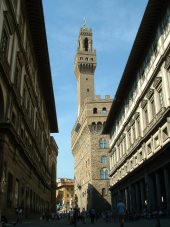 Palazzo Vecchio, Florence
Photo: BPG
The Palio delle Contrade,
Siena
July
A banner, decorated with an image of the Virgin Mary, is presented to the winner of a horse race around the Siena's Piazza del Campo. Competitors come from each one of the 17 districts of the city.
The race consists of bareback riders making three circuits of the main square and is over in 90 seconds. But it is preceded by 5 hours of flag throwing acrobatics around the main square.
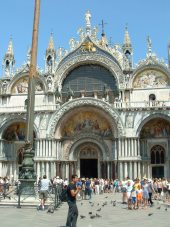 St. Marco Basilica, Venice
Photo: BPG
Viareggio
February - March
Every year The Viareggio Carnival is the most spectacular in Italy, and is known world-wide. The people of Viareggio begin preparing the huge papier-maché puppets in hangar-like buildings by the sea. The figures satirise public and political figures; making them and setting them atop the floats requires considerable technical skill as well as creativity and imagination.
The voluminous floats parade around Viareggio competing for the finest float award from 2.30pm until 9pm on the following dates: 11, 18, 25, 27 Feb and 4 March, each one carrying about 200 people in costume, as well as the huge moving, Trojan horse-like puppets, which hold people inside to manoeuvre the weights, counter-weights and levers that prevent them from toppling over.
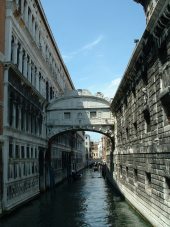 The Bridge of Sighs, Venice
Photo: BPG
|